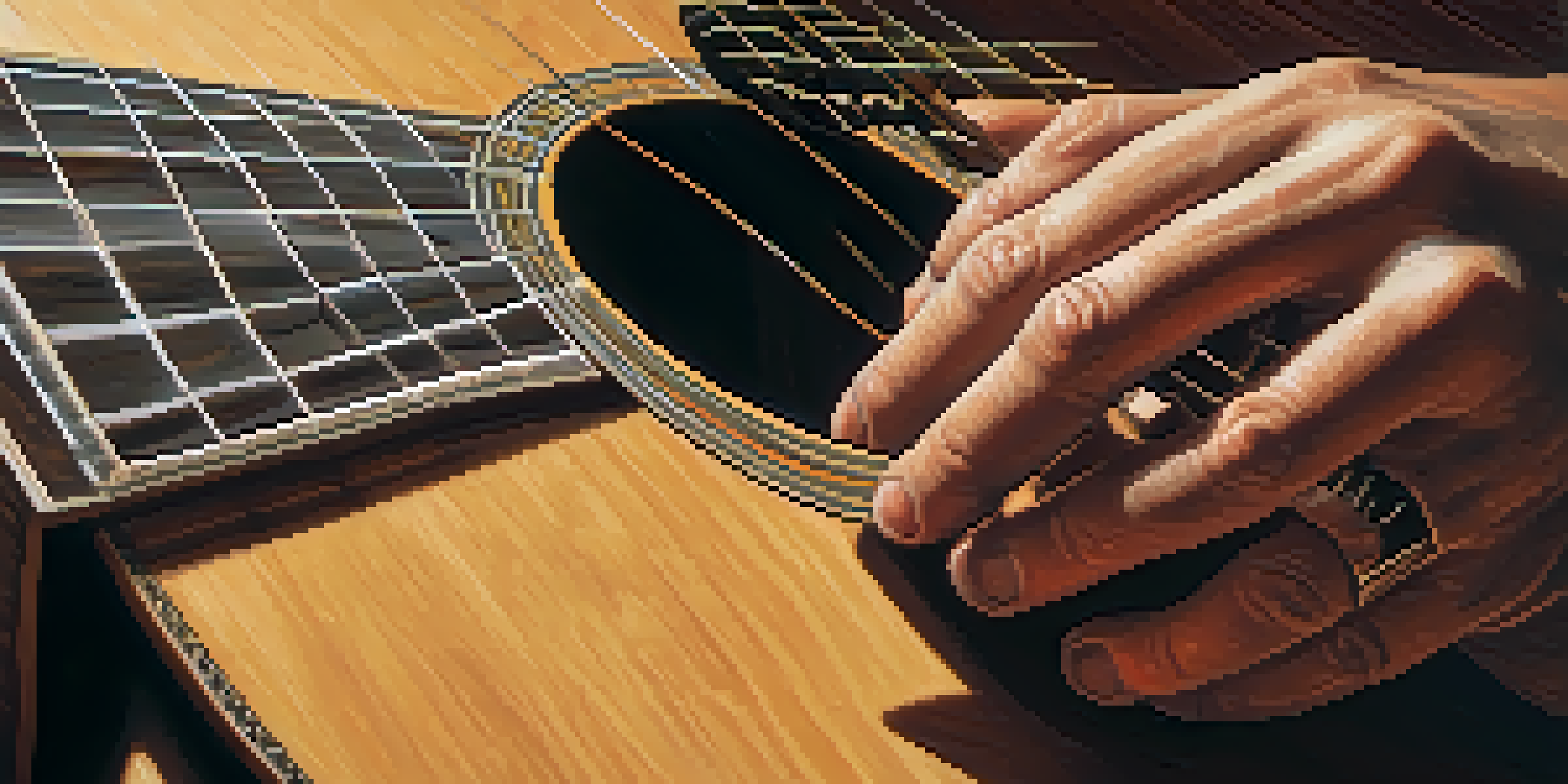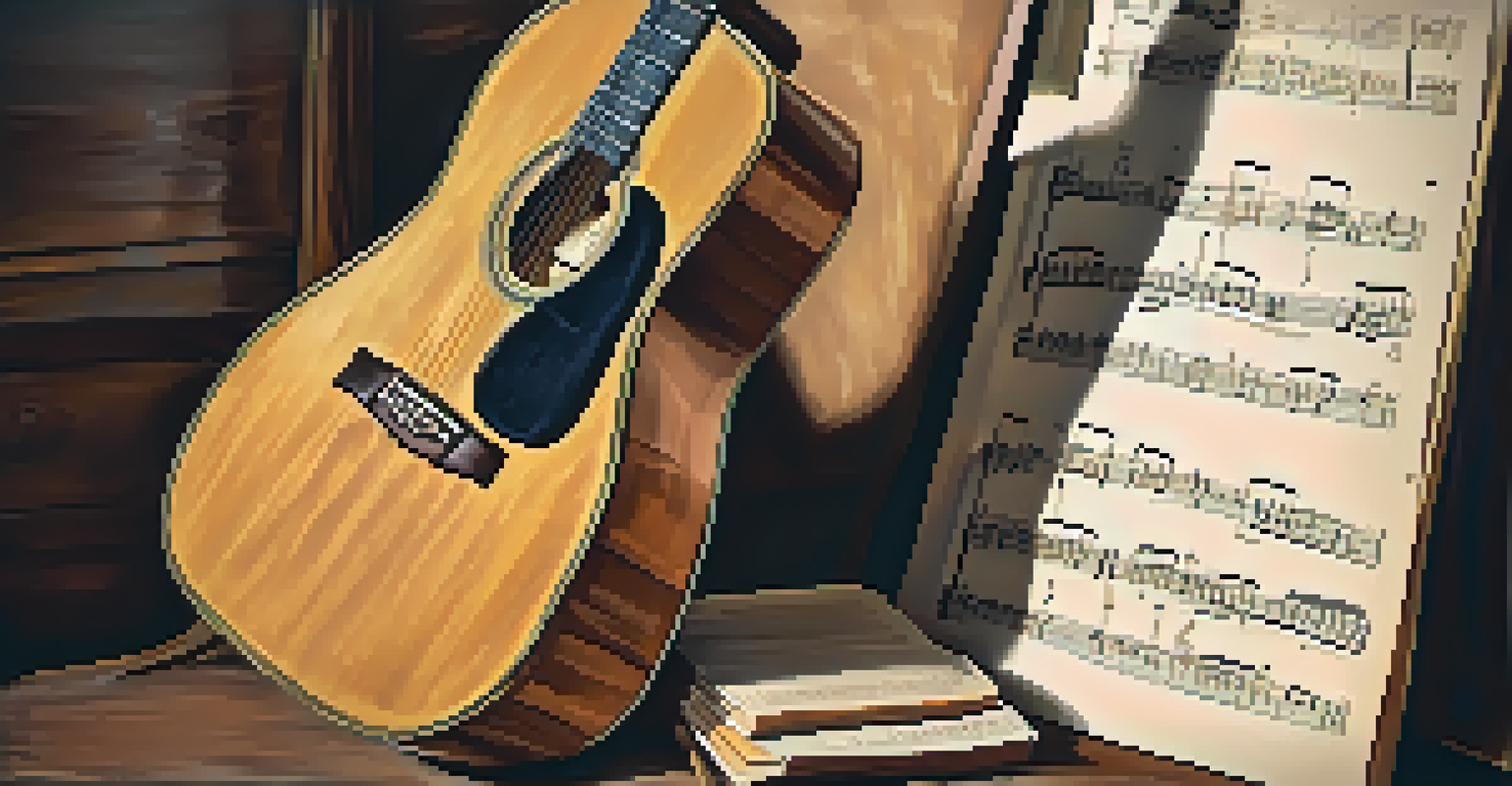The Art of Fingerstyle Guitar: Expressing Yourself Musically

What is Fingerstyle Guitar? Understanding the Basics
Fingerstyle guitar is a technique where the player uses their fingers instead of a pick to pluck the strings. This approach allows for a more intricate and personal sound, effectively combining melody, harmony, and rhythm all at once. Many famous artists, like Tommy Emmanuel and Andy McKee, exemplify this style, showcasing its versatility and emotional depth.
Music is the shorthand of emotion.
Unlike traditional strumming, fingerstyle lets you create complex arrangements that can evoke a wide range of emotions. This technique opens up a world of creative possibilities, allowing you to express your musical ideas in unique ways. Whether playing a soft ballad or an upbeat tune, fingerstyle can bring out the nuances in your performance.
Moreover, learning fingerstyle techniques can enhance your overall guitar skills. It encourages a more intimate connection with your instrument, promoting greater awareness of tone and dynamics. As you explore this style, you’ll find that it not only enriches your playing but also deepens your appreciation for music.
Essential Techniques for Fingerstyle Guitar Playing
To master fingerstyle guitar, it’s essential to learn some foundational techniques. These include thumb independence, where your thumb plucks the bass notes while your fingers handle the melody. Practicing finger picking patterns can significantly improve your coordination and fluidity, allowing you to play more complex pieces with ease.

Another vital technique is the use of harmonics, which can add a shimmering quality to your sound. By lightly touching the string with your finger while plucking, you can create ethereal tones that captivate the listener. Experimenting with these techniques can lead to a richer, more textured sound in your playing.
Mastering Fingerstyle Techniques
Learning essential fingerstyle techniques like thumb independence and dynamics enhances your overall guitar skills and musical expression.
Lastly, don’t forget about dynamics. Playing softly and loudly can dramatically change the emotional impact of your music. By incorporating varying volumes and articulation in your fingerstyle playing, you’ll be able to convey feelings more effectively, making your performances truly memorable.
The Importance of Rhythm in Fingerstyle Guitar
Rhythm is the heartbeat of any musical piece, and in fingerstyle guitar, it plays a crucial role. It's not just about playing the right notes but also about creating a rhythmic foundation that supports your melody. This is where fingerstyle shines, as it allows you to interweave bass lines and melodies in a way that keeps the music moving.
The guitar is a miniature orchestra in itself.
Using a metronome can help you develop a strong sense of timing. Start slow, focusing on accuracy and gradually increasing your speed as you become more comfortable. By nailing the rhythm, your fingerstyle pieces will have a solid groove that makes them more engaging for listeners.
Additionally, incorporating syncopation can add an exciting twist to your playing. This rhythmic technique involves placing emphasis on unexpected beats, creating a lively and dynamic feel. By mastering rhythm in your fingerstyle guitar, you’ll elevate your musical expression and captivate your audience.
Choosing the Right Guitar for Fingerstyle Playing
When it comes to fingerstyle guitar, the right instrument can make all the difference. Many players prefer acoustic guitars for their warm, resonant tones that complement fingerpicking techniques beautifully. However, the choice of guitar also depends on your personal preference and playing style.
Consider the size and shape of the guitar, as these factors can affect your comfort and playing experience. Smaller guitars, like parlor models, can be easier to manage for intricate fingerstyle work, while larger dreadnoughts provide a fuller sound. Testing different guitars can help you find one that feels just right in your hands.
Rhythm is Key in Fingerstyle
Developing a strong sense of rhythm through practice and techniques like syncopation elevates your fingerstyle performances.
Lastly, don't overlook the importance of string selection. Lighter gauge strings are often recommended for fingerstyle playing, as they are easier to fret and pluck. Experimenting with different string materials can also enhance your tone, making your fingerstyle guitar sound even more expressive.
Building Your Fingerstyle Repertoire
As you embark on your fingerstyle journey, building a diverse repertoire is essential. Start with simple pieces that allow you to practice the techniques you've learned, gradually moving on to more complex compositions. Popular songs often have fingerstyle arrangements that can help you gain confidence and experience.
Don’t hesitate to explore different genres, as fingerstyle can be applied to folk, classical, blues, and even pop music. Each genre offers unique challenges and rewards, broadening your musical horizons. For instance, learning a classical piece can enhance your technical skills, while a blues tune can deepen your understanding of improvisation.
Also, consider writing your own fingerstyle compositions. This process can be incredibly rewarding and allows you to express your individuality as a musician. As you create and arrange your music, you'll not only improve your playing but also discover your unique voice in the world of guitar.
Practicing Effectively: Tips for Fingerstyle Guitarists
Effective practice is crucial for mastering fingerstyle guitar. Start by setting specific goals for each practice session, whether it’s perfecting a particular technique or learning a new song. Breaking down complex pieces into manageable sections can prevent feeling overwhelmed and ensure steady progress.
Incorporating various exercises into your routine will also enhance your skills. Focus on finger independence, chord transitions, and rhythmic patterns to build a solid foundation. Additionally, recording yourself can provide valuable feedback, allowing you to track your improvement and identify areas for growth.
Building a Diverse Repertoire
Exploring various genres and creating your own compositions is crucial for developing your unique voice as a fingerstyle guitarist.
Finally, don’t forget to include time for improvisation and experimentation in your practice. This can foster creativity and help you develop your unique style. By balancing structured practice with free exploration, you’ll become a more versatile and expressive fingerstyle guitarist.
The Emotional Connection: Playing Fingerstyle Guitar
One of the most beautiful aspects of fingerstyle guitar is its ability to convey deep emotions. The intimacy of fingerpicking allows you to express feelings that words might fail to capture. When you play, think about the story or emotion you want to communicate, and let that guide your performance.
As you develop your fingerstyle skills, focus on how you can evoke different emotions through dynamics and phrasing. A soft, gentle touch can create a feeling of nostalgia, while a more aggressive attack might convey excitement. The key is to be aware of how your playing affects the listener and strive to connect with them emotionally.

Ultimately, fingerstyle guitar is about finding your voice and sharing your unique musical perspective. Embrace the journey of self-expression, and remember that every note you play is an opportunity to connect with others. By pouring your heart into your music, you’ll inspire and resonate with your audience in profound ways.